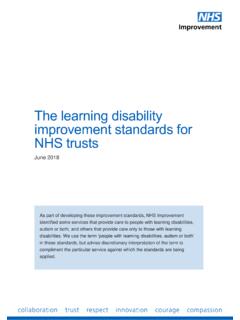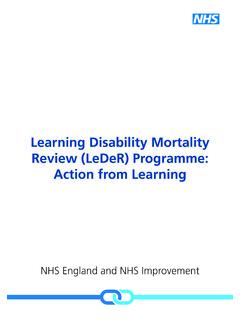Transcription of Racial and Ethnic Differences in the Prevalence of ...
1 NCHS Data Brief No. 358 March DEPARTMENT OF HEALTH AND HUMAN SERVICESC enters for Disease Control and PreventionNational Center for Health StatisticsRacial and Ethnic Differences in the Prevalence of Attention-deficit/Hyperactivity Disorder and learning Disabilities Among Children Aged 3 17 YearsBenjamin Zablotsky, , and Josephine M. Alford, findingsData from the National Health Interview Survey, 2016 2018 In 2016 2018, nearly 14% of children aged 3 17 years were reported as ever having been diagnosed with either attention-deficit/hyperactivity disorder (ADHD) or a learning disability ; non-Hispanic black children were the most likely to be diagnosed ( ). Among children aged 3 10 years, non-Hispanic black children were more likely to have ever been diagnosed with ADHD or a learning disability compared with non-Hispanic white or Hispanic children.
2 Diagnosis of ADHD or a learning disability differed by federal poverty level for children in all Racial and Ethnic groups. Diagnosis of ADHD or a learning disability differed by parental education among non-Hispanic white children only. Attention-deficit/hyperactivity disorder (ADHD) and learning disabilities are the most commonly diagnosed neurodevelopmental disorders in children and often coexist (1,2). Previous research has suggested that the Prevalence of these conditions may differ by race and Hispanic origin (3,4). Using timely, nationally representative data, this report examines the reported Prevalence of ADHD and learning disabilities by race and ethnicity and select demographic characteristics that are associated with the diagnosis of these conditions (1).
3 Does the Prevalence of diagnosed ADHD or a learning disability vary by race and ethnicity? In 2016 2018, of children aged 3 17 years had ever been diagnosed with either ADHD or a learning disability . Non-Hispanic black children ( ) were more likely than non-Hispanic white ( ) or Hispanic ( ) children to be diagnosed with either condition (Figure 1).NCHS reports can be downloaded from: different from Hispanic children (p < ).2 Significantly different from non-Hispanic white children (p < ).NOTES: Estimates are based on household interviews of a sample of the civilian noninstitutionalized population. Diagnosed attention-deficit/hyperactivity disorder (ADHD) (by a doctor or other health professional) and diagnosed learning disability (by a school representative or a health professional) is based on parent or guardian report.
4 Overall, of children aged 3 17 were ever diagnosed with either ADHD or a learning disability . In total, of children were diagnosed with ADHD only, were diagnosed with a learning disability only, and were diagnosed with both ADHD and a learning disability . Access data table for Figure 1 at: #1. SOURCE: NCHS, National Health Interview Survey, 2016 1. Prevalence of children aged 3 17 years ever diagnosed with attention-deficit/hyperactivity disorder or a learning disability , by race and ethnicity: United States, 2016 2018 05101520 HispanicNon-Hispanic blackNon-Hispanic , Data Brief No. 358 March 2020 2 Non-Hispanic white children were more likely to be diagnosed with ADHD or a learning disability than Hispanic children.
5 Does the Prevalence of diagnosed ADHD or a learning disability vary by both race and ethnicity and age? Overall, children aged 3 10 years ( ) were less likely to ever be diagnosed with ADHD or a learning disability compared with children aged 11 17 years ( ). This pattern was consistent across all Racial and Ethnic groups (Figure 2). Among children aged 3 10 years, non-Hispanic black children ( ) were more likely to be diagnosed with ADHD or a learning disability than non-Hispanic white ( ) or Hispanic ( ) children. Among children aged 11 17 years, Hispanic children ( ) were less likely to be diagnosed with ADHD or a learning disability than non-Hispanic black ( ) and non-Hispanic white ( ) different from children aged 11 17 years (p < ).
6 2 Significantly different from non-Hispanic white children aged 3 10 years (p < ).3 Significantly different from Hispanic children aged 3 10 years (p < ).4 Significantly different from Hispanic children aged 11 17 years (p < ).NOTES: Estimates are based on household interviews of a sample of the civilian noninstitutionalized population. Diagnosed attention-deficit/hyperactivity disorder (by a doctor or other health professional) and diagnosed learning disability (by a school representative or a health professional) is based on parent or guardian report. Access data table for Figure 2 at: #2. SOURCE: NCHS, National Health Interview Survey, 2016 2. Prevalence of children aged 3 17 years ever diagnosed with attention-deficit/hyperactivity disorder or a learning disability , by age group and race and ethnicity: United States, 2016 2018 Percent0510152025 HispanicNon-Hispanic blackNon-Hispanic whiteTotal11 17 years3 10 Data Brief No.
7 358 March 2020 3 Does the Prevalence of diagnosed ADHD or a learning disability vary by both race and ethnicity and family poverty level? Overall, children living in families at less than 100% of the federal poverty level ( ) were more likely to be diagnosed with ADHD or a learning disability compared with children living in families at 100% or more of the federal poverty level ( ). This pattern was consistent across all Racial and Ethnic groups (Figure 3). Among children living in families at less than 100% of the federal poverty level, non-Hispanic white ( ) and non-Hispanic black ( ) children were more likely to be diagnosed with ADHD or a learning disability than Hispanic children ( ). Similarly, among children living in families at 100% or more of the federal poverty level, non-Hispanic white ( ) and non-Hispanic black ( ) children were more likely to be diagnosed with ADHD or a learning disability than Hispanic children ( ).
8 1 Significantly different from children living in families at 100% or more of the federal poverty level (p < ).2 Significantly different from Hispanic children living in families at less than 100% of the federal poverty level (p < ).3 Significantly different from Hispanic children living in families at 100% or more of the federal poverty level (p < ).NOTES: Estimates are based on household interviews of a sample of the civilian noninstitutionalized population. Diagnosed attention-deficit/hyperactivity disorder (by a doctor or other health professional) and diagnosed learning disability (by a school representative or a health professional) is based on parent or guardian report. Access data table for Figure 3 at: #3. SOURCE: NCHS, National Health Interview Survey, 2016 3.
9 Prevalence of children aged 3 17 years ever diagnosed with attention-deficit/hyperactivity disorder or a learning disability , by family poverty level and race and ethnicity: United States, 2016 2018 PercentHispanicNon-Hispanic blackNon-Hispanic whiteTotal051015202530100% or more of federal poverty levelLess than 100% offederal poverty , , Data Brief No. 358 March 2020 4 Does the Prevalence of diagnosed ADHD or a learning disability vary by both race and ethnicity and parental educational attainment? Overall, children with parents who have a high school education or less ( ) were more likely to be diagnosed with ADHD or a learning disability when compared with children with parents who have more than a high school education ( ) (Figure 4).
10 Among children with parents who have a high school education or less, non-Hispanic white children ( ) were more likely to be diagnosed with ADHD or a learning disability than non-Hispanic black ( ) and Hispanic ( ) children. Among children with parents who have more than a high school education, non-Hispanic black children ( ) were more likely to be diagnosed with ADHD or a learning disability than non-Hispanic white ( ) and Hispanic ( ) children. Among non-Hispanic white children, those with parents who have a high school education or less were more likely to be diagnosed with ADHD or a learning disability compared with children with parents who have more than a high school different from children with parents who have more than a high school education (p < ).











